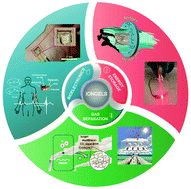Emerging iongel materials towards applications in energy and bioelectronics
Abstract
In the past two decades, ionic liquids (ILs) have blossomed as versatile task-specific materials with a unique combination of properties, which can be beneficial for a plethora of different applications. The additional need of incorporating ILs into solid devices led to the development of a new class of ionic soft-solid materials, named here iongels. Nowadays, iongels cover a wide range of materials mostly composed of an IL component immobilized within different matrices such as polymers, inorganic networks, biopolymers or inorganic nanoparticles. This review aims at presenting an integrated perspective on the recent progress and advances in this emerging type of material. We provide an analysis of the main families of iongels and highlight the emerging types of these ionic soft materials offering additional properties, such as thermoresponsiveness, self-healing, mixed ionic/electronic properties, and (photo)luminescence, among others. Next, recent trends in additive manufacturing (3D printing) of iongels are presented. Finally, their new applications in the areas of energy, gas separation and (bio)electronics are detailed and discussed in terms of performance, underpinning it to the structural features and processing of iongel materials.



 Please wait while we load your content...
Please wait while we load your content...
